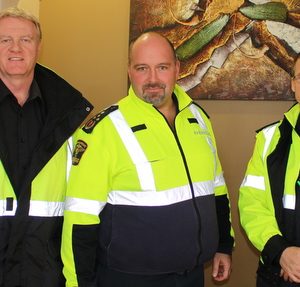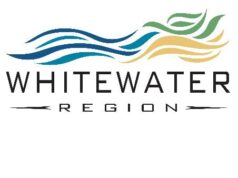By CONNIE TABBERT
Editor
COBDEN — A few years ago, the former council of Whitewater Region was successful in getting a satellite ambulance station in Cobden.
But, in the blink of an eye, and without the current council being informed, the satellite station was shut down.
Marsha Hawthorne, Deputy-Chief Administrative Officer for the township, advised during the protective services committee meeting Jan. 6, that the perception of safety by the township residents was removed when the ambulance was no longer stationed in Cobden.
Chief Mike Nolan, who is the director of Paramedic Services for Renfrew County, along with Deputy Chiefs Michel Ruest and Brian Leahey, spoke about the paramedic service throughout the county, as well as within the borders of Whitewater Region, at the Jan. 6 committee meeting.
Chief Nolan reviewed a variety of statistics, including the county paramedics having to provide coverage to about 7,600 square kilometres, as well as into Alqonquin Park. They respond to an excess of 22,000 calls per year, he said. In the day time, there are 10 units patrolling the county, while at night, it goes down to seven units. The three extra units during the day are located in Cobden, Calabogie and Killaloe as much as possible.
Chief Nolan said the response times for people over the age of 65 has been tracked over the years, because they are the ones who use the ambulances the most, so that is where the ambulances are placed. He advised there is an in-depth report available about where the calls have been over the past few years and if any member of council is interested in the report, they can talk to him.
There are challenged areas that have lower call volume, and that includes La Passe in Whitewater Region, he said. Whitewater is not fully covered by an ambulance due to where they are located at various times, Chief Nolan said. However, due to the economics, it’s just not possible to have an ambulance in every area of the county, he said.
There had been discussion about the possibility of building an ambulance base in Cobden with an ambulance and two paramedics a few years ago, but that was not economically feasible, Chief Nolan explained. Instead, one of the standby ambulances was posted to Whitewater, mainly in the Cobden area.
The service was expanded and the Community Paramedic Response Unit was created. This unit is a Ford Explorer type of vehicle with a paramedic who is to focus on contributing to health care by improving integration with community stakeholders, such as community health centres, home support services, seniors’ homes and events, with a focus on health promotion and illness prevention, he said.
“The idea is they get to the people before they need us, all in an effort to decrease our response,” he said.
There were two units and Whitewater provided office space where two paramedics could start and end their day, Chief Nolan said. Their productivity was low, he said, but there was success, in that the federal and provincial governments provided money for more of these paramedic units on the road, growing from two to five.
That is why the two paramedics were removed from Cobden and relocated to Renfrew, which is where all of the mobile units meet to start their day, he explained. The station needed to have a garage, which is legislated under the Ambulance Act, Chief Nolan said.
These community paramedic units reach 13,000 people each year and response time for emergency has increased by about 15 minutes because they can also respond to emergency calls, sometimes arriving before the ambulances do, he explained.
However, Chief Nolan said the error was this change in plan was not communicated to Whitewater Region council.
“We have maintained the room downstairs, and it is a drop-in site for the community paramedics to be used for administration, be able to touch down and be able to go back out,” he said.
If there is a paramedic in an office, that is not good Chief Nolan said, even though if people see them in the area, that makes them they feel safe. Chief Nolan said he wants these paramedic units out in the community.
Showing statistics, he said the number of responses in Whitewater Region fluctuates.
“We’ve been able to maintain about a 63 percent average,” he said. “This means, that 63 percent of the emergency calls that occur in Whitewater Region over the same time period (last year), we were able to get community paramedics also responding, and they are the highest trained paramedics in Renfrew County.”
He noted emergency calls have decreased in Whitewater Region because by getting to someone frail and vulnerable prior to being required, they are 80 percent less likely to call 911 and that’s a huge success. That means the ambulances can be used for “those truly, emergency calls.”
In reviewing statistics for Whitewater Region, the paramedics were able to visit 165 people in six months. In the six months after moving the paramedics out of Cobden to Renfrew and then directing them to the municipality for the day, there have been 365 clients visited, Chief Noland explained.
“We’re more efficient by putting them all in one place at the start of the day, pushing them into your community, knowing they are still doing emergency calls, but more importantly, getting to your most vulnerable people … and doing it in a co-ordinated fashion,” he said.
He admitted starting the five paramedics out of Cobden is a preferred location, but there isn’t space for the vehicles, the paramedics, necessary supplies and a mechanic. The purchase by the county of the former Canadian Tire building in Renfrew gave them the necessary space, he said.
The goal of the paramedic service is to improve outcomes, Chief Nolan said. He believes that has been achieved with the community paramedic response unit. He reviewed a list of what this unit provides, including wound care clinics at Renfrew Victoria Hospital, point of care check-ups, medication management and compliance, falls and fall prevention, immunization and flu shots, ultrasounds, community referrals and assessment and care management, not only to those in senior homes, but at various senior events, as well as home visits as requested. It is no longer just an ambulance service, he said.
The ultrasounds are a pilot program which just started, he said. By using an ultrasound at an accident site, the paramedics are able to decide if the patient can go to a local hospital or needs the specialized care of the Ottawa hospitals, he explained.
Chief Nolan noted response time for the community paramedic response unit is just over five minutes while an ambulance is just under 10 minutes.
“We always believe we can do better,” he said.
He noted that 10 years ago, the cardiac arrest survival rate in Renfrew County was 1.3 percent.
“This past year, we have the best survival rate in all of eastern Ontario at just shy of 14 percent,” Chief Nolan said, adding, “We would like to save everyone, but we know we can’t. But, to save the most people with the resources we have available, we’ve shown significant improvement.”
Councillor Daryl McLaughlin recalled sitting at the council table following the tragic death of a resident of Beachburg because an ambulance could not get to the person in time.
“Our service, are we getting the same service,” he questioned. “I know the vehicles aren’t here anymore until eight o’clock (at night), but are they around our catchment area, being Cobden, Beachburg, Westmeath? Are those vehicles still being there as much as when they were here (at the municipal hall)?”
Chief Nolan said the data shows the municipality is getting three times the service due to productivity, explaining that the demand for service is decreasing because of the community paramedic outreach program.
“The data … shows that the service has significantly improved,” Chief Nolan said. “The service is better than it ever has been, despite the fact they are not starting and stopping their day in Cobden versus Renfrew.”
Chief Nolan said any loss of life is tragic, but the service is helping the most the best it can.
“For some people, no matter what we do, it’s not going to make a difference, while for others, there is a subset of the population where the response time matters, as does the care you provide when you get there,” he explained.
There will always be circumstances where the outcome will not be changed and that is a tragedy, Chief Nolan said.
Ms. Hawthorne said when her husband died in 2010, there was a legislated response time of 19 minutes and they responded to her 911 call in 26 minutes. She questioned now that the paramedics are in Renfrew, what is the response time is to La Passe.
Chief Nolan said the data is showing the response time is better across Whitewater Region.
“It is substantially better than 11 years ago when I arrived here,” he said, adding, “The La Passe area continues to be challenged due to its geographic make-up.”
However, with the community paramedic response units in Whitewater, they can respond right away, he added. There is only the 30 minutes in the morning and evening when that unit is not in the township, he said.
Ms. Hawthorne said the presence of the paramedic units in Cobden gave the residents the sense of being safe if something were to happen. However, not knowing they moved, didn’t sit well with staff or people in the community.
She said she questioned about La Passe, because her father, who lives in La Passe, was having heart trouble and her mother, instead of calling 911 opted to bring him to the hospital because she feared the ambulance wouldn’t arrive in time.
“I’d like for taxpayers to feel comfortable, for the amount of taxes that they pay for the services of health care, because when you need it, and if you’ve never needed it thank God you didn’t, but when you do need 911, you want it there fast,” she said.
When the paramedic unit was relocated to Cobden, it was agreed there would be 12 hours of coverage, Ms. Hawthorne said. She believes that time has been cut down to almost eight hours, because the paramedics must start and end their day in Renfrew, which includes having time to do paperwork and other necessary administration work.
Also, she pointed out spreading that eight hours between Haley, Cobden, Beachburg and La Passe is very tough.
“We need something better,” Ms. Hawthorne said. “We weren’t asked if we had a building where we could host one of your vehicles. I know you had it here and plugged it in here. But, we have a garage, we have a fire hall. Maybe we could have built something.
“This never came to us,” she said, continuing, “This should have come to staff, so council and taxpayers could have been advised.”
Ms. Hawthorne was glad to hear that when a person calls 911, the dispatcher must give an estimated time of arrival for the ambulance, because this will then give the person calling time to make the decision whether to wait or drive the person to the hospital.
Ms. Hawthorne said the residents had the perception of being safe when the ambulance was located in Cobden.
Chief Nolan said feeling safe is important, but being seen and getting out there and doing the job is also important.






![Kenopic/Smith Auction [Paid Ad]](https://whitewaternews.ca/wp-content/uploads/2018/10/advertising-100x75.jpeg)

